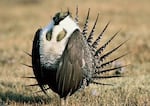
A male great western sage grouse.
U.S. Fish and Wildlife Service
There's good news for the West's imperiled greater sage grouse. New research suggests the bird has a better chance of survival when juniper trees are removed from its habitat.
The chicken-sized sage grouse's decline has happened over the same stretch of time that's seen western juniper and pinyon pine trees spread out across the bird's sagebrush ecosystem. Reasons for the trees' expansion include fire suppression, overgrazing and changing climate conditions.
As the stands grow more dense, they outcompete sagebrush. They also serve as perches for birds of prey.
That's bad for the greater sage grouse.
These trees are one of the problems with the birds' habitat. A new study out of Oregon State University found — when you cut down encroaching conifer trees — the sage grouse population grows by 25 percent.
"We are tremendously excited," said study co-author Christian Hagen, an avian ecologist at Oregon State University. "The arrow is pointing in the right direction. The grouse are finding these areas where the juniper was taken out much more quickly than we anticipated."
The birds' population did not increase in a control area where juniper and pinyon trees continued to slowly creep across the ecosystem.
The researchers collected data from 2010-2014 in southeastern Oregon, northeastern California and northwestern Nevada. Sage grouse habitat ranges across 173 million acres in the West.
In this study, researchers cut down or burned trees to remove them. They left trees that were more than 100 years old standing.
Researchers say reducing encroaching conifer trees will also help other species of concern, like Brewer's sparrow.
In 2015, because of efforts from a wide range of conservationists, ranchers, and state plans, the federal government decided the greater sage grouse did not warrant a listing under the Endangered Species Act.
Other threats to the greater sage grouse include habitat fragmentation from development, larger wildfires spurred by invasive cheatgrass, and habitat loss from energy development and mining. Threats to the greater sage grouse have been likened to “a death by a thousand cuts.”
The study was published in the journal
.
